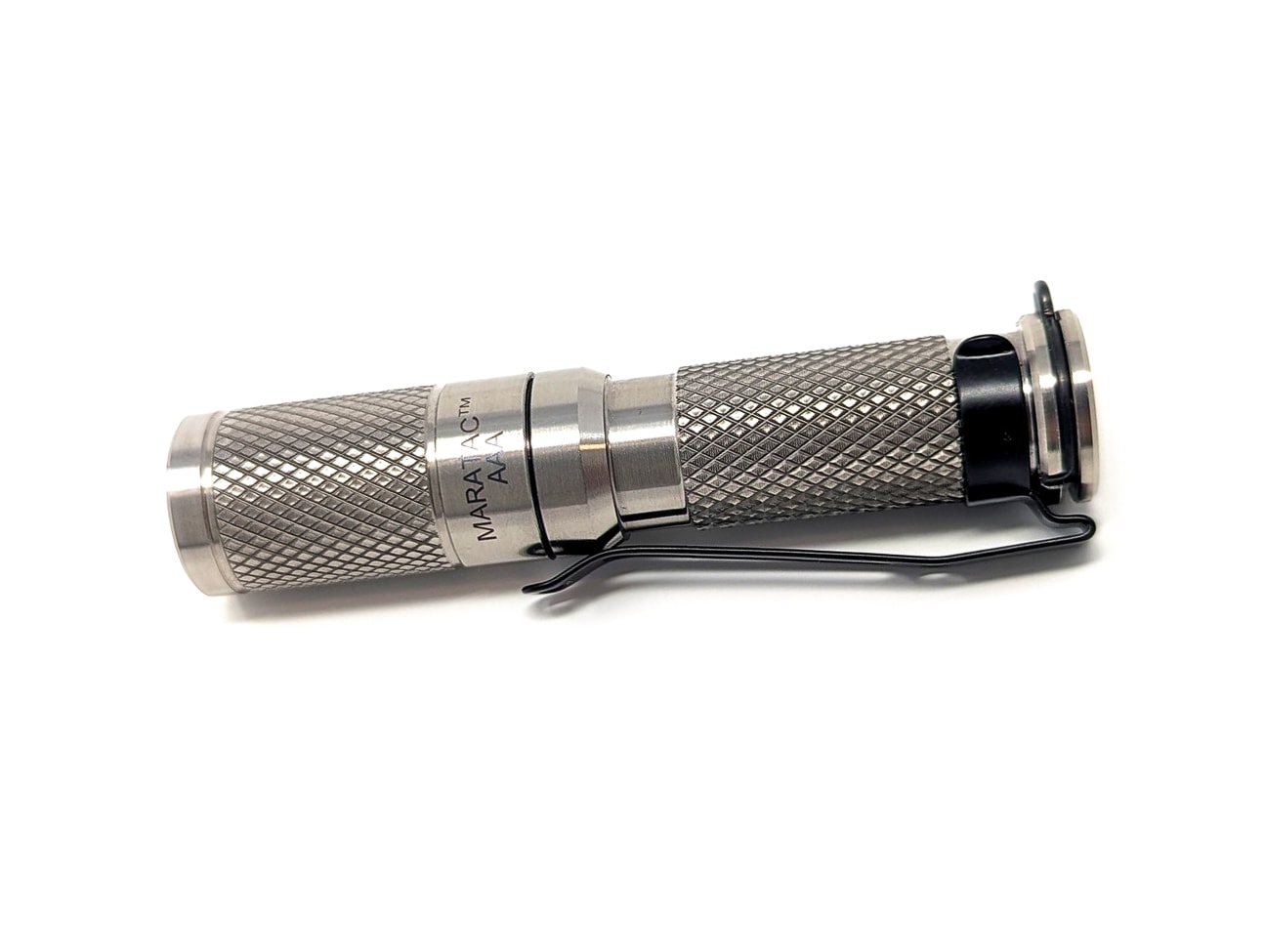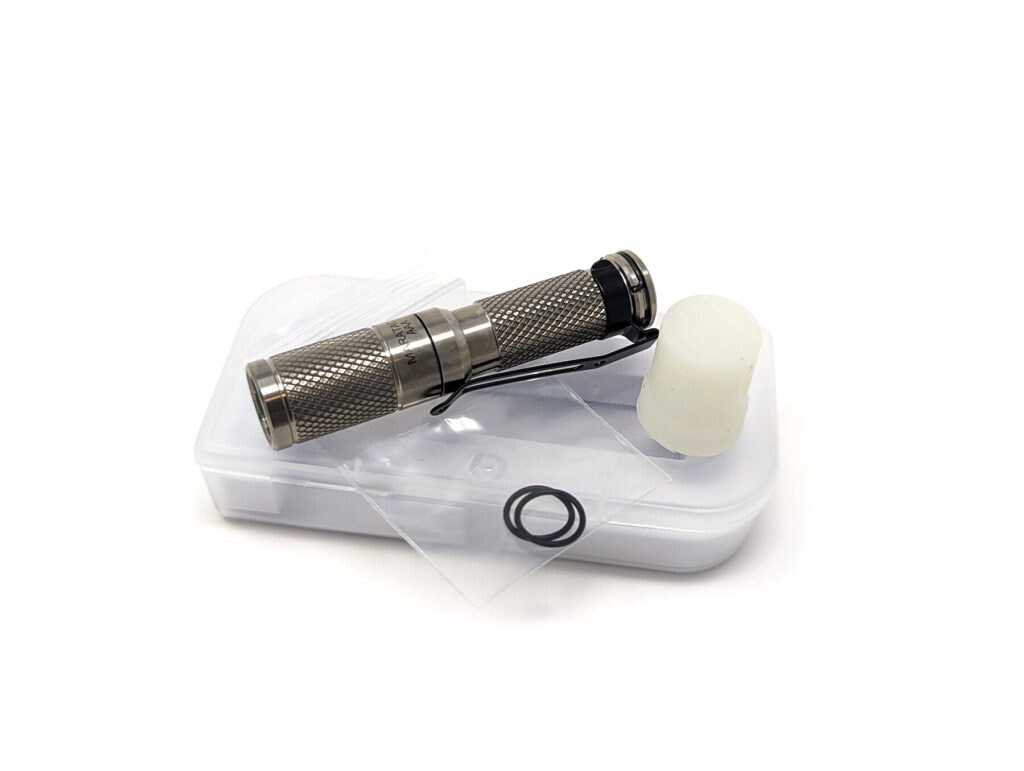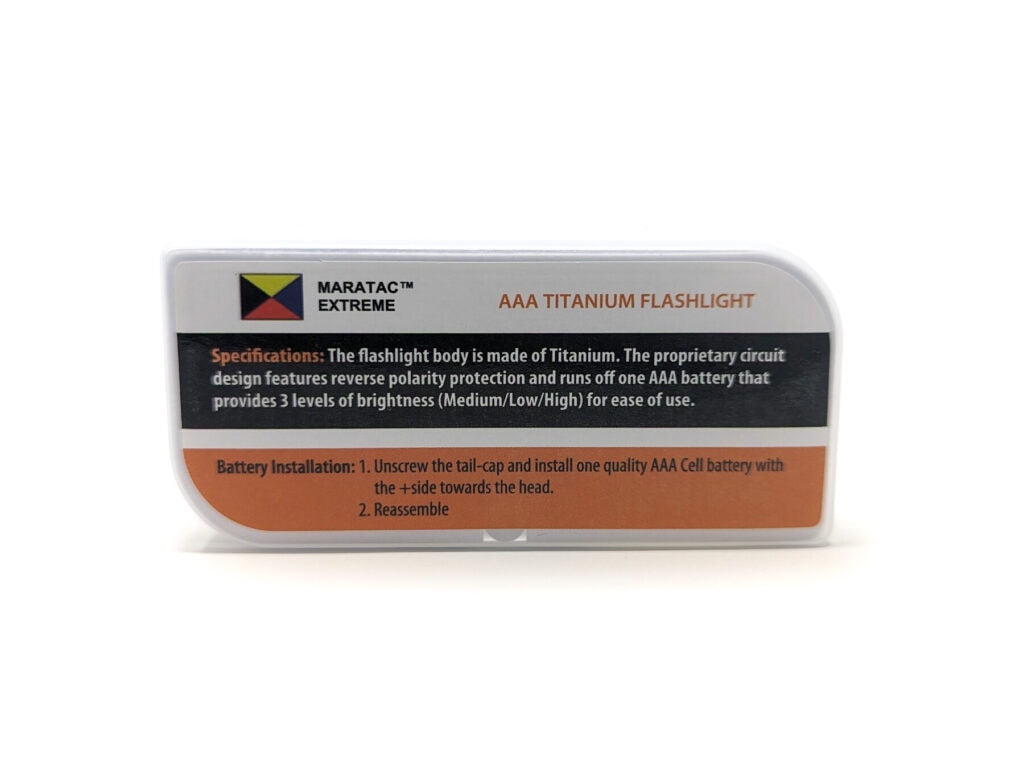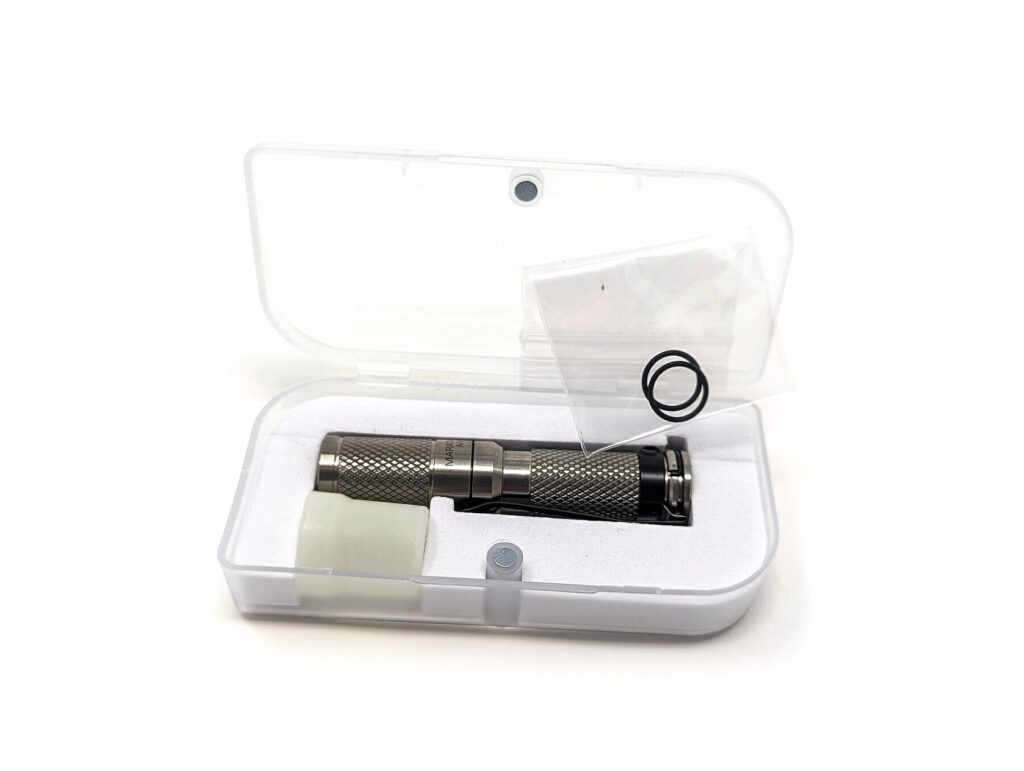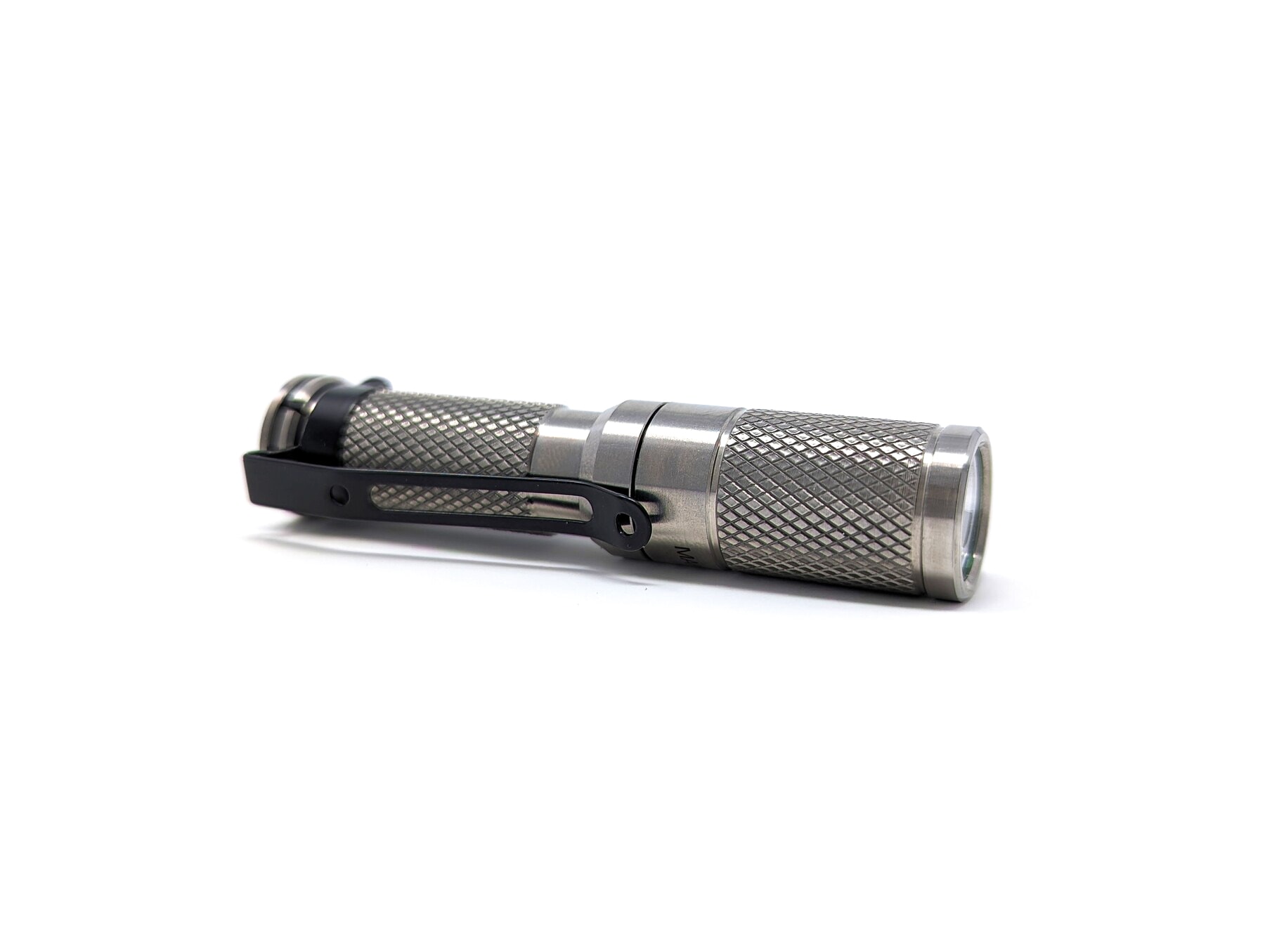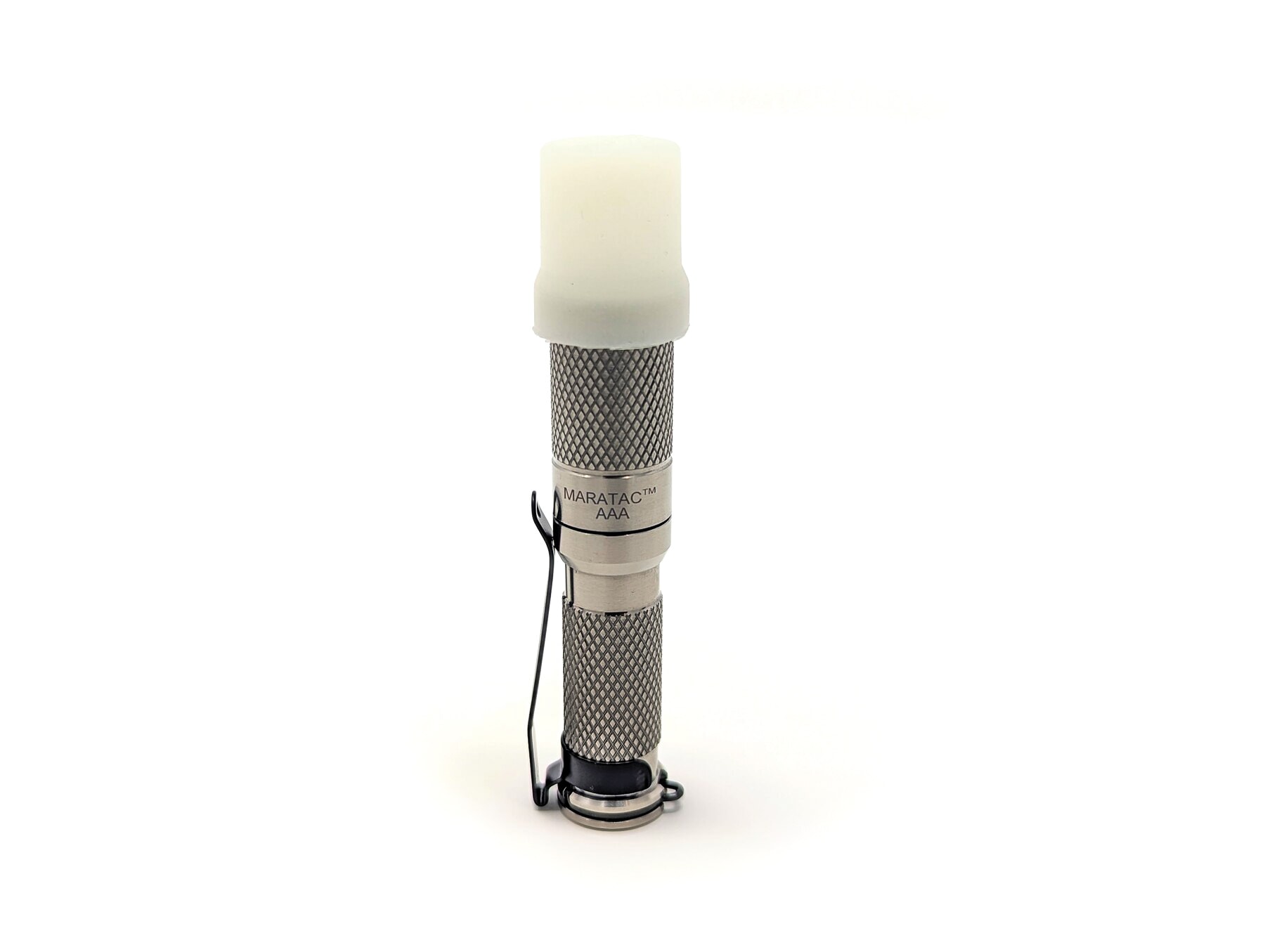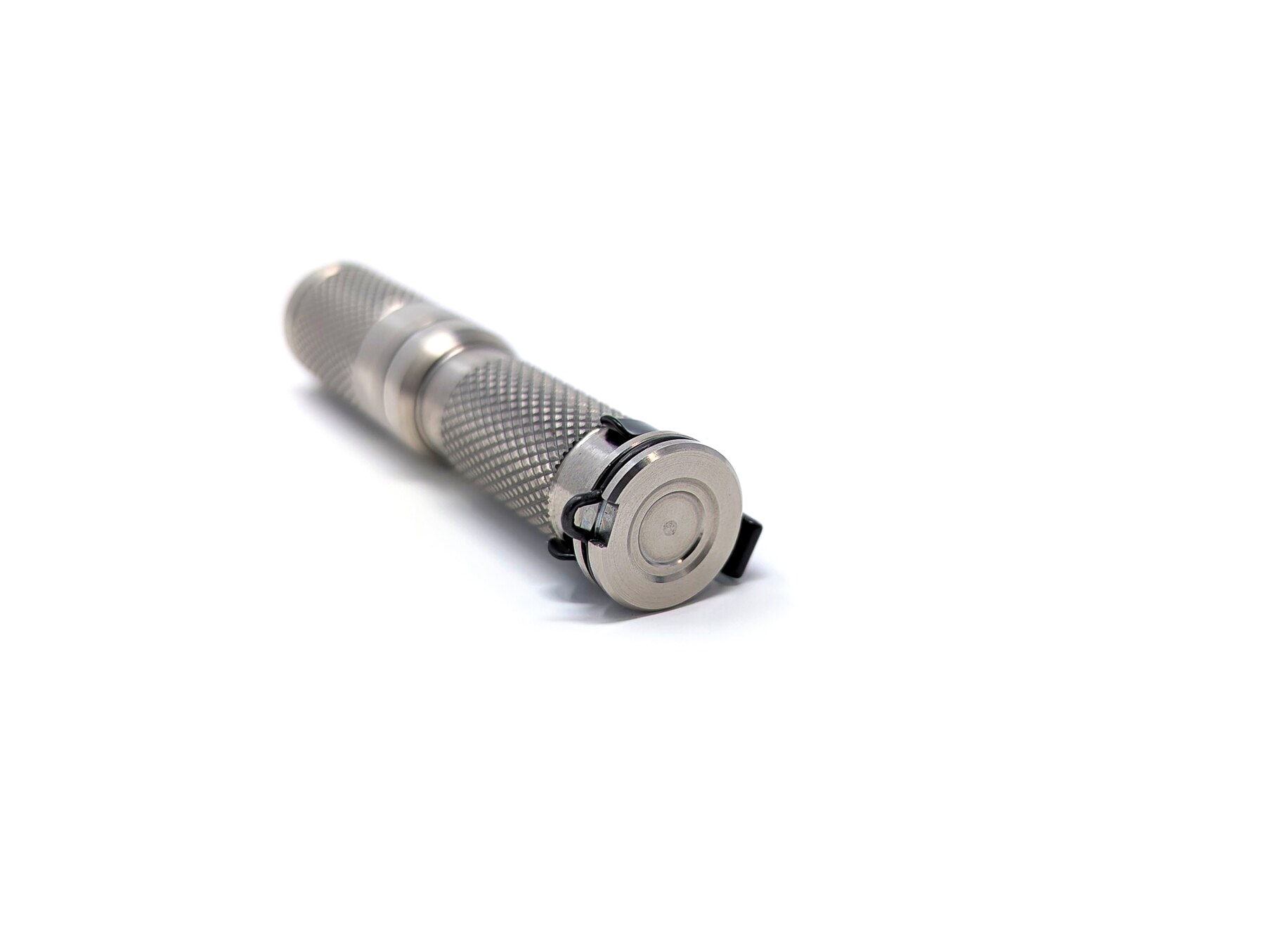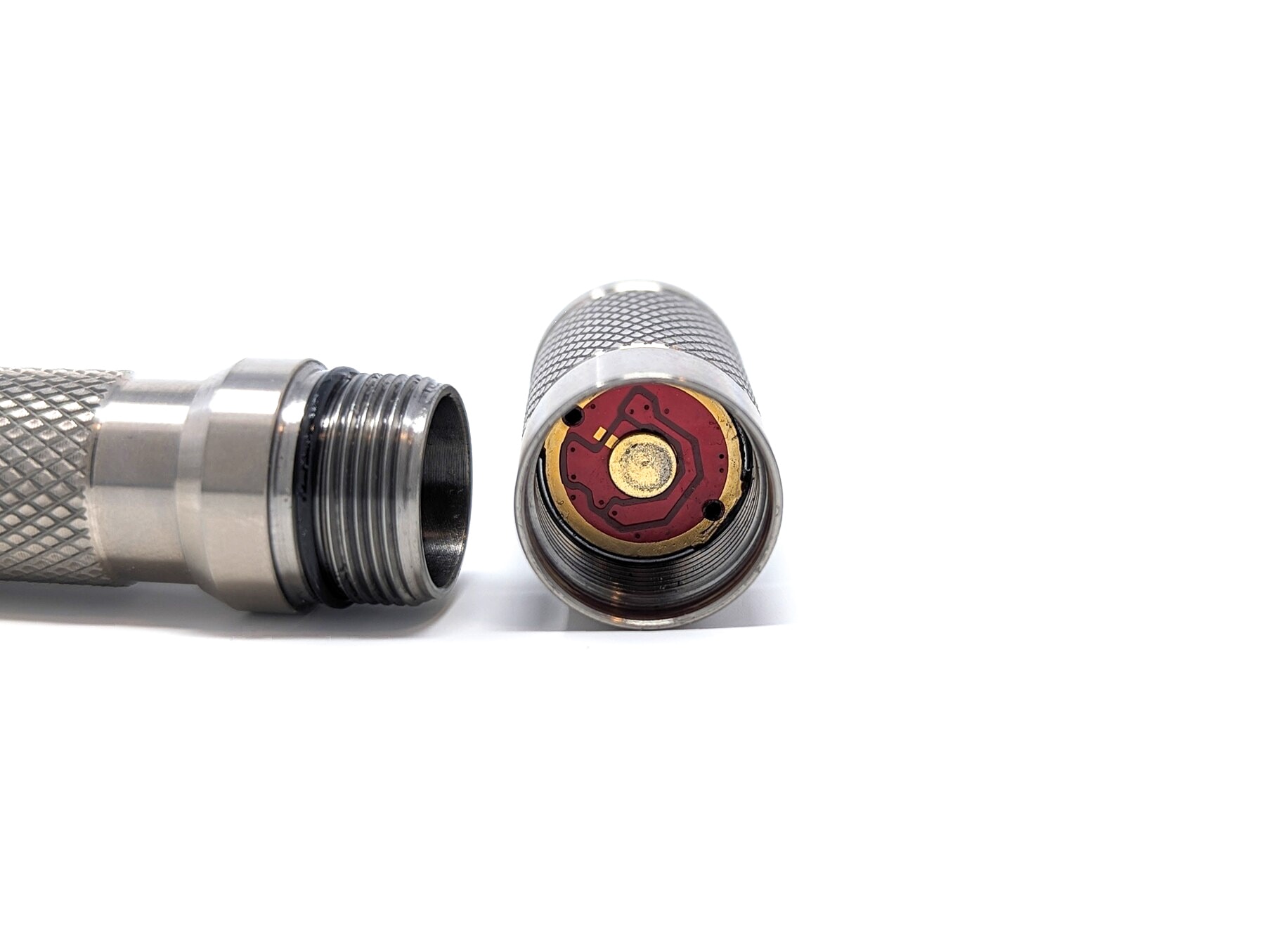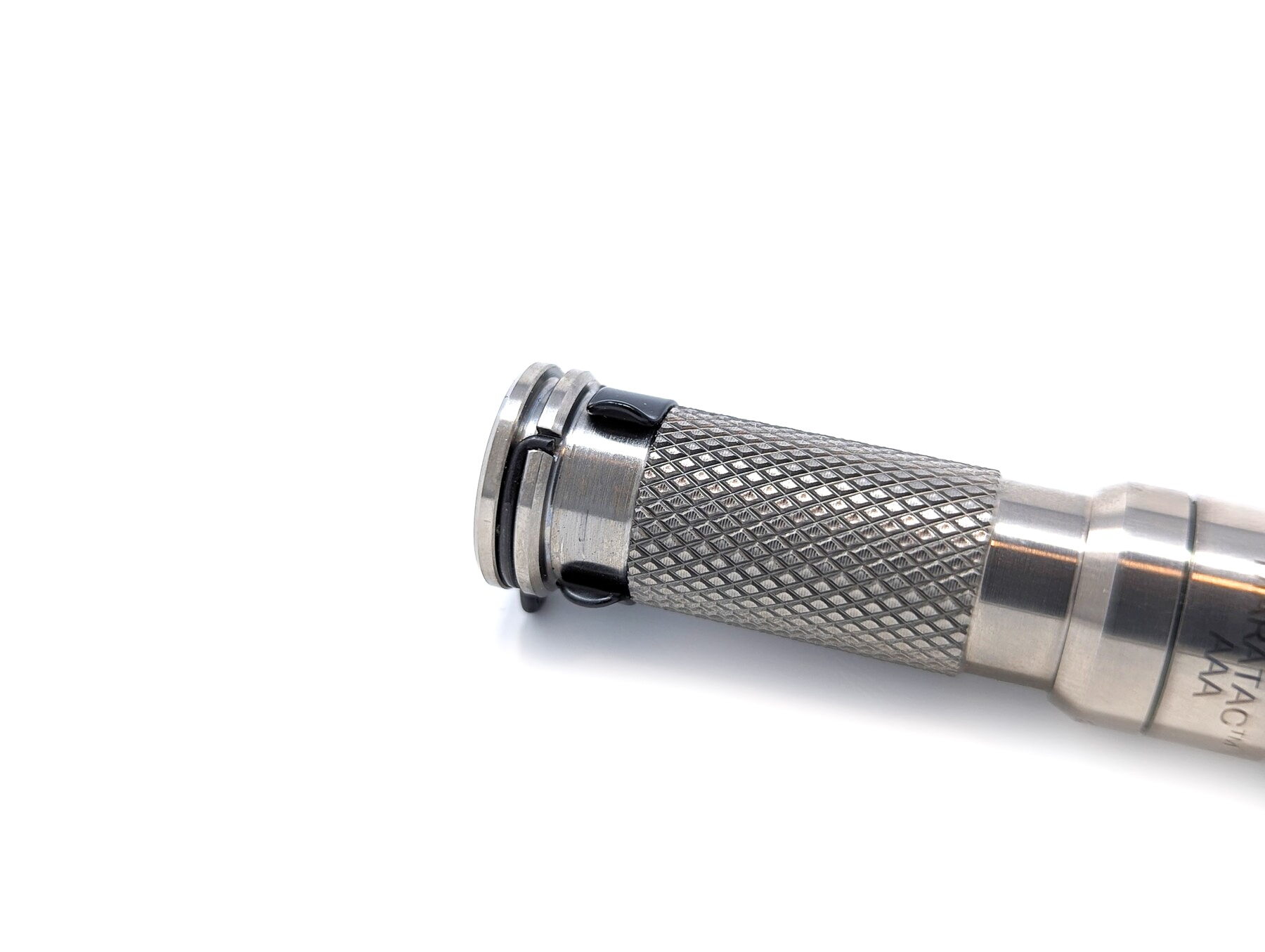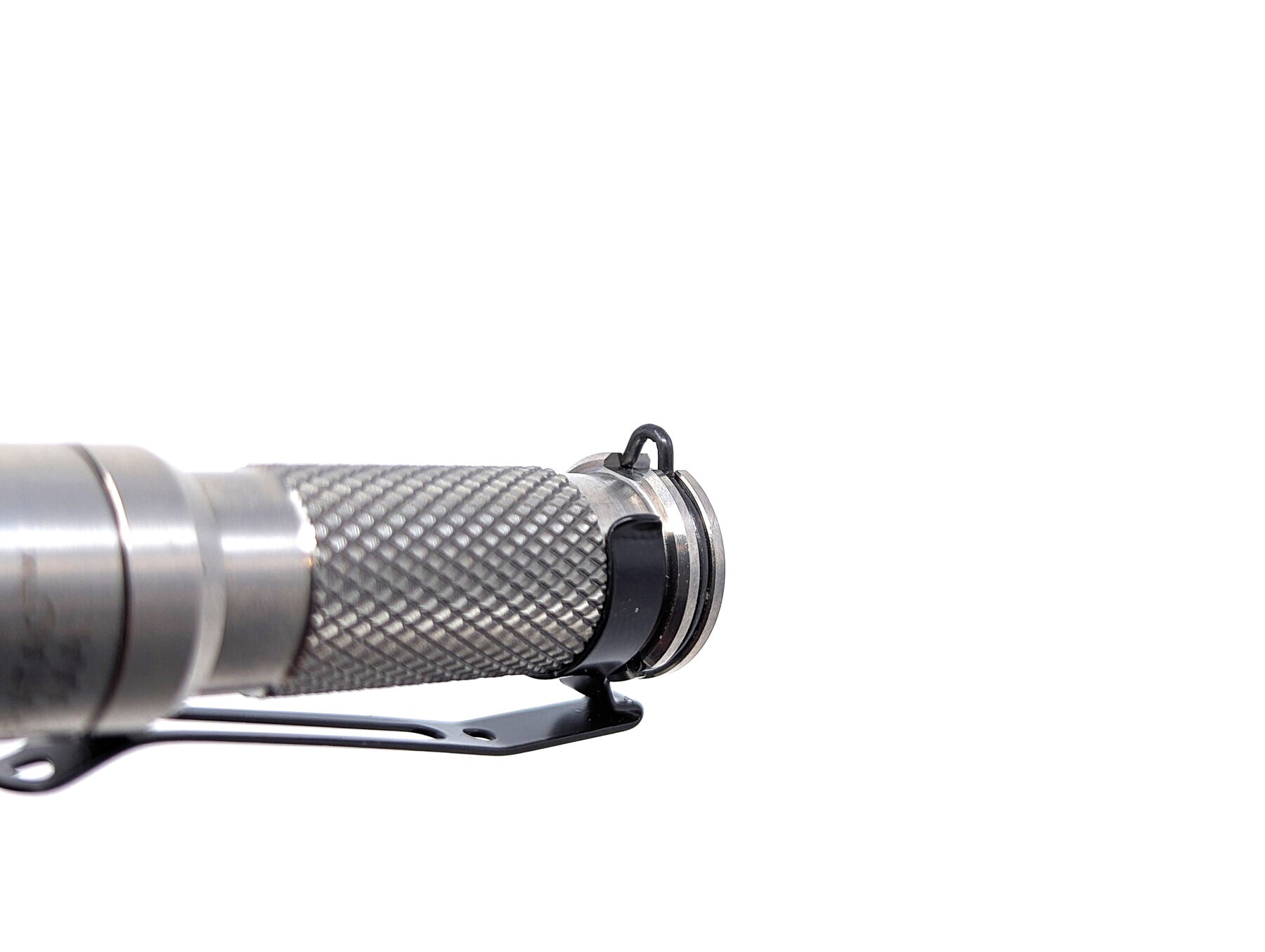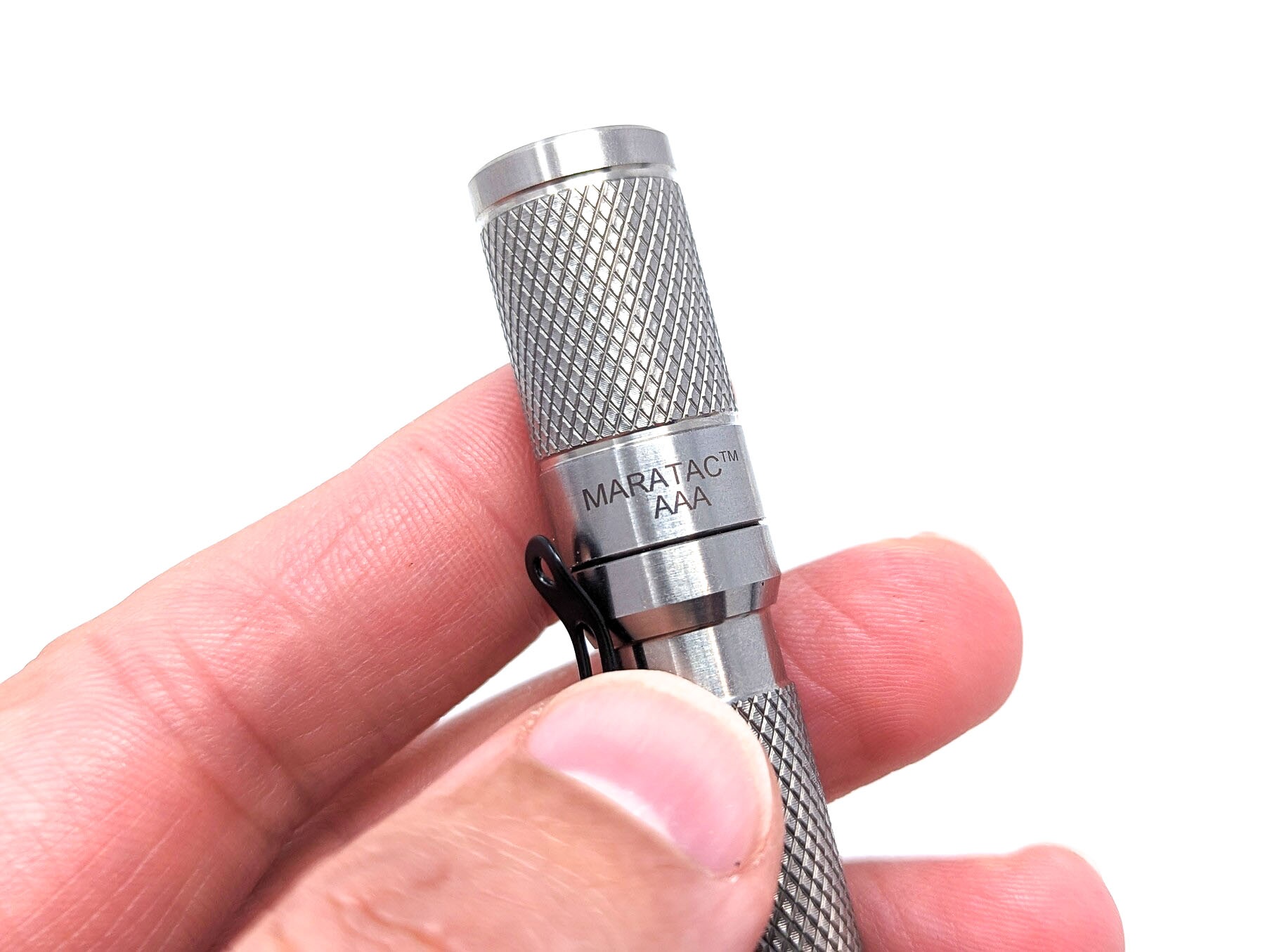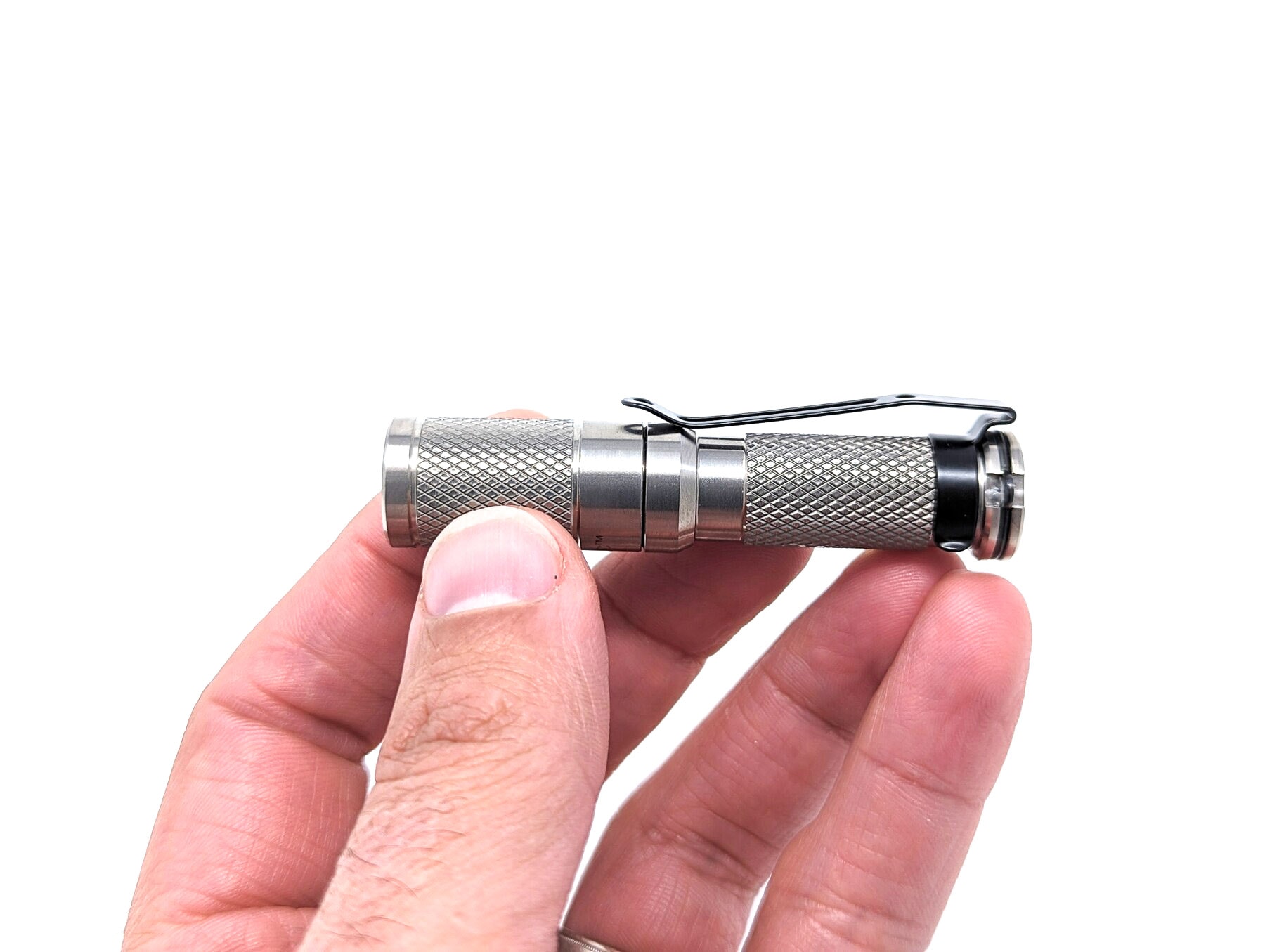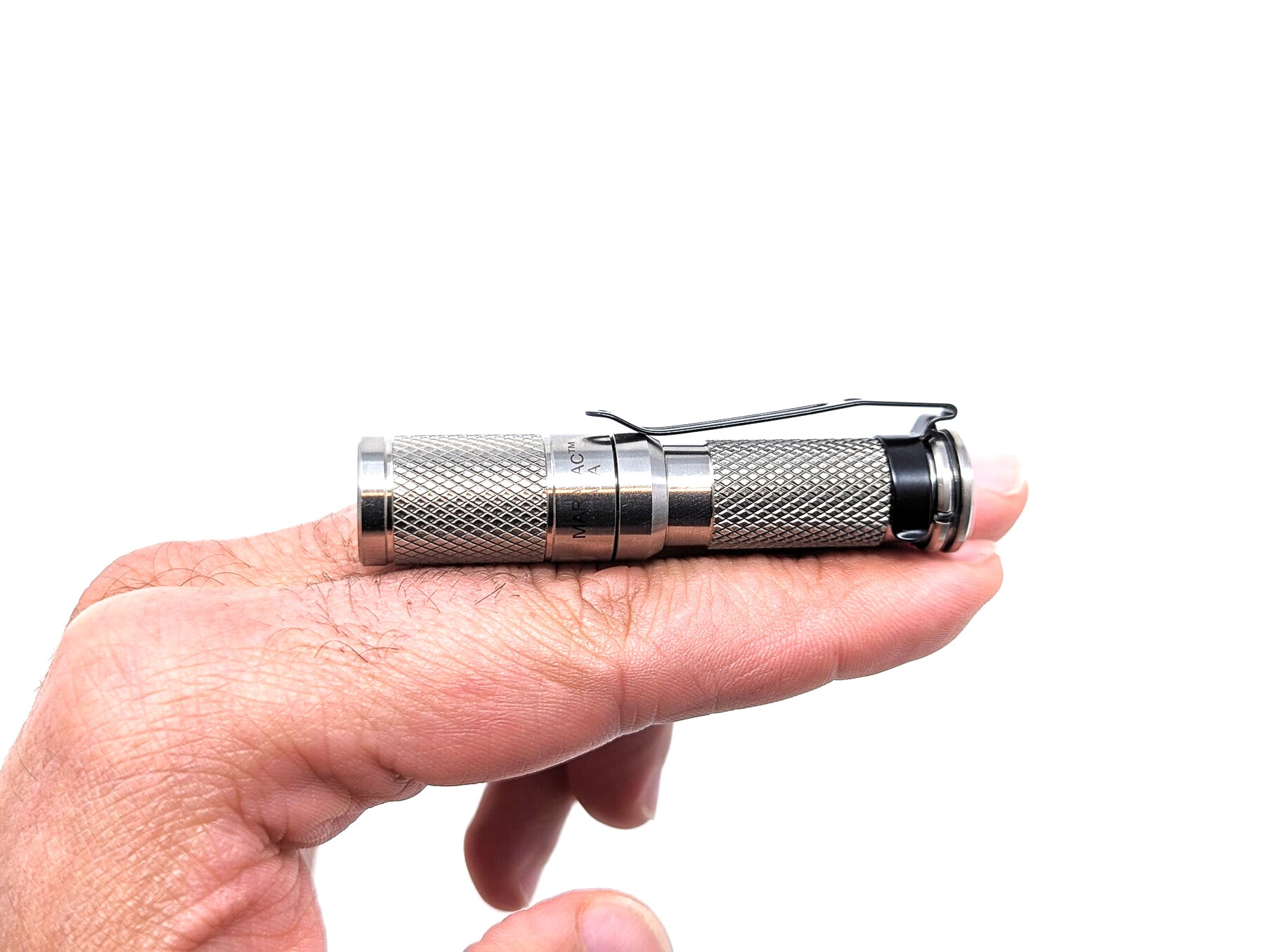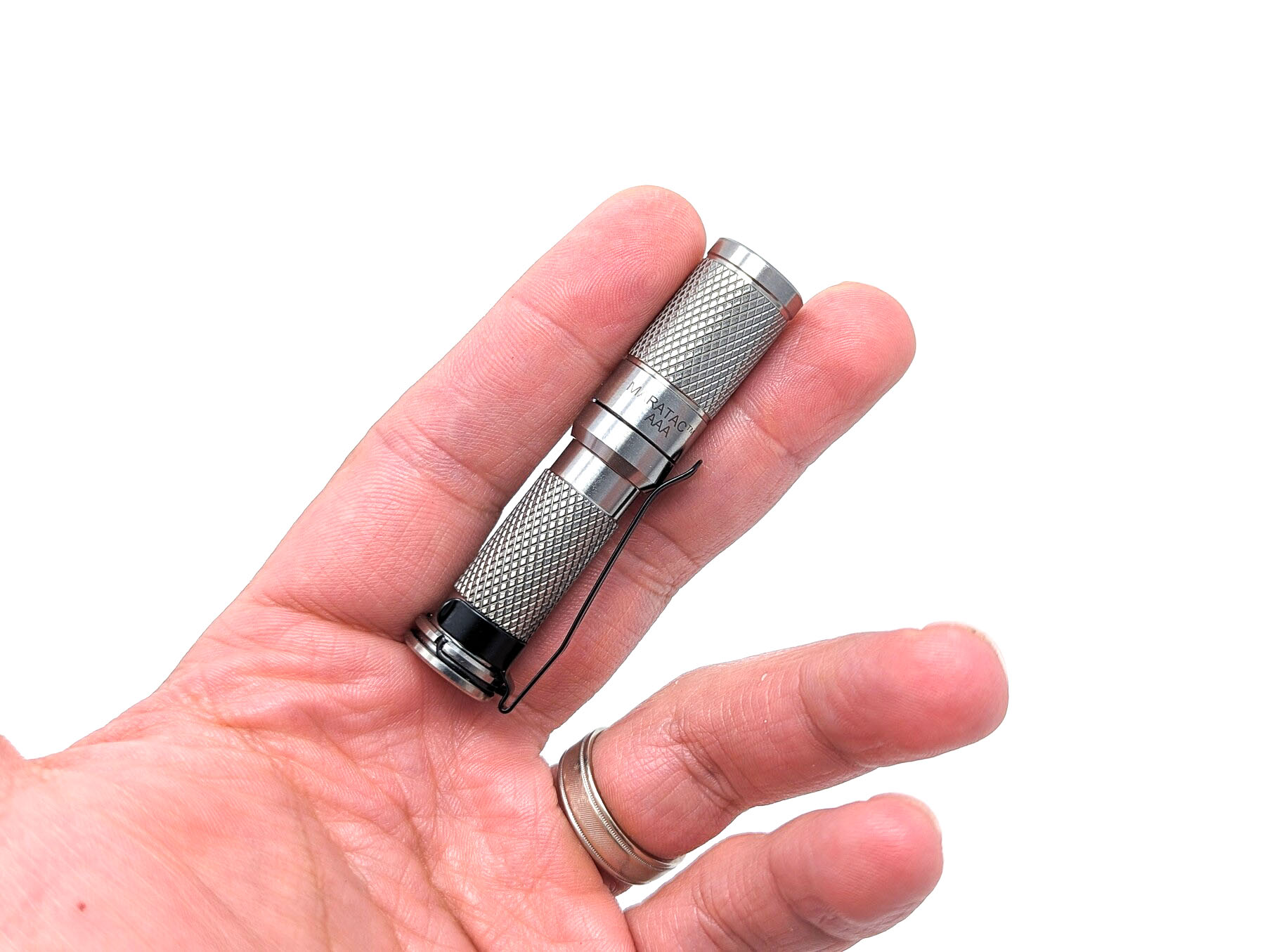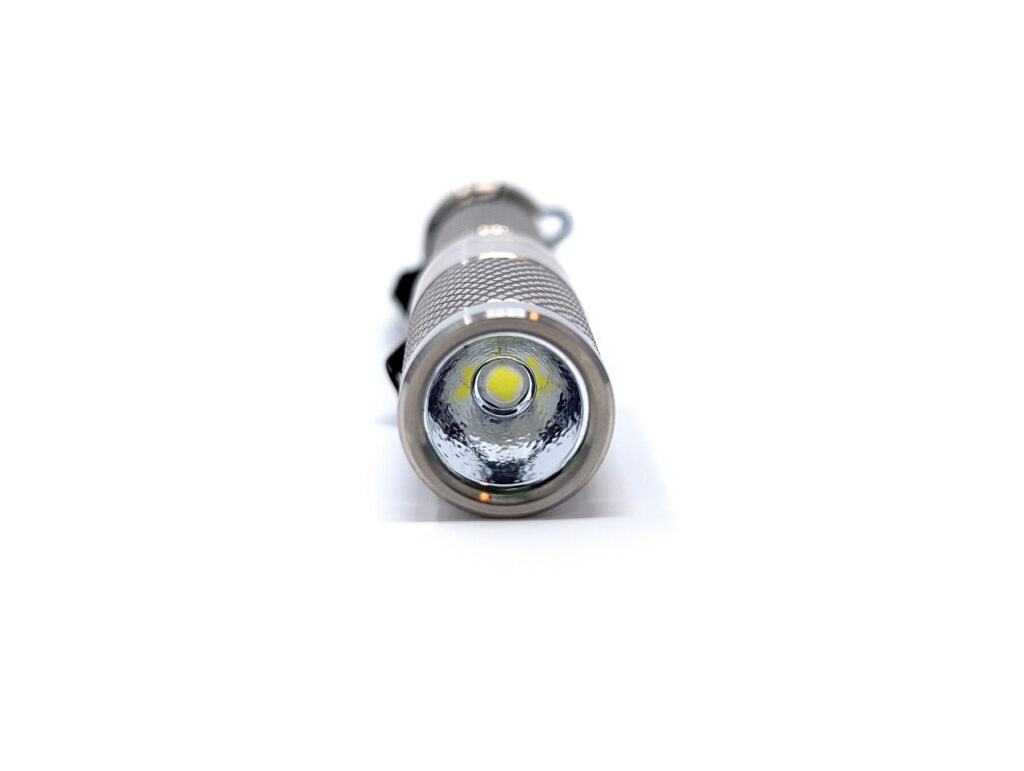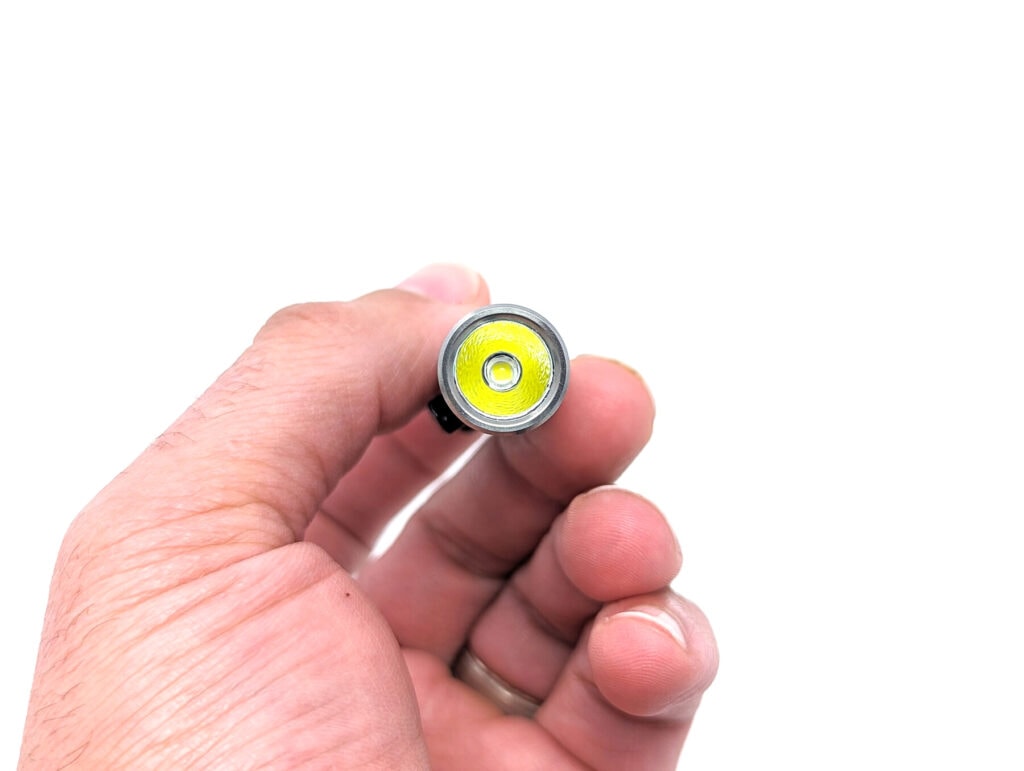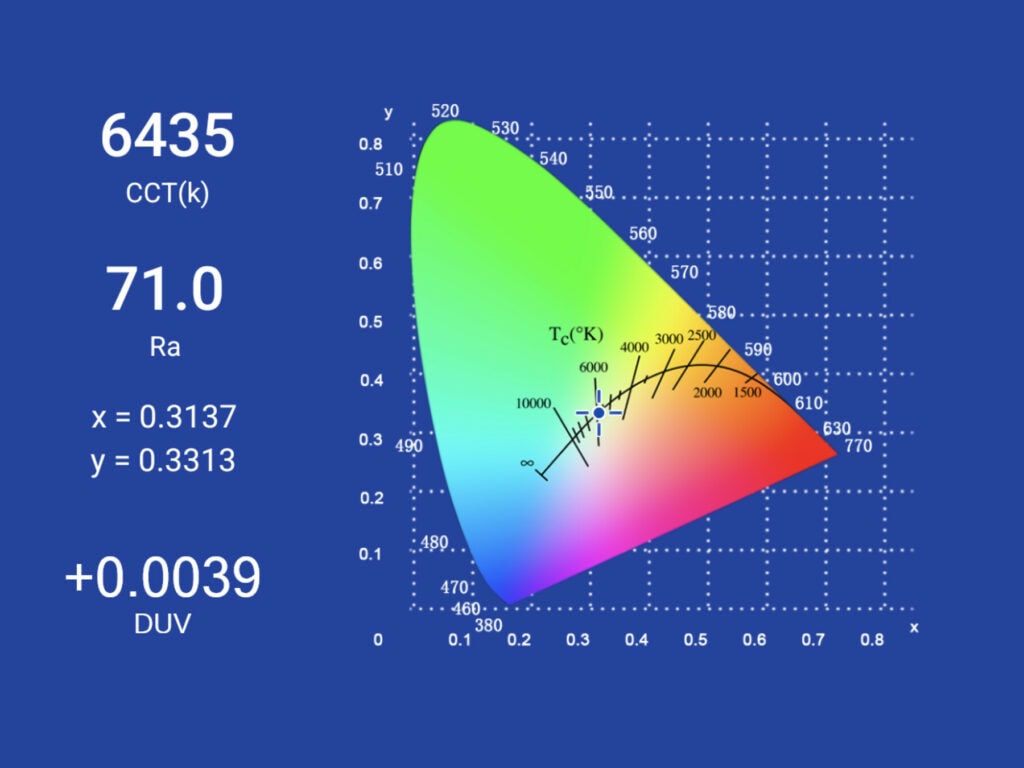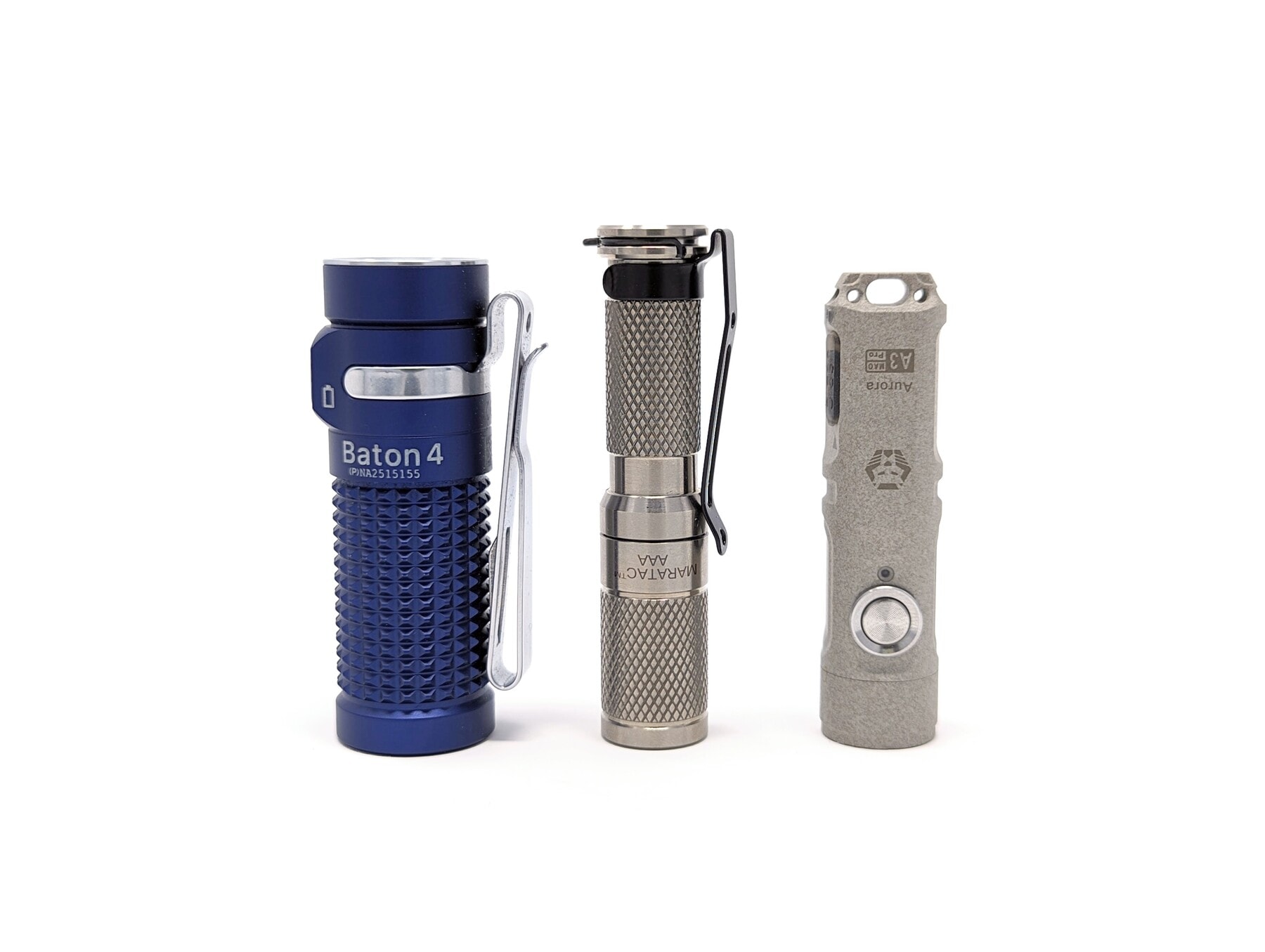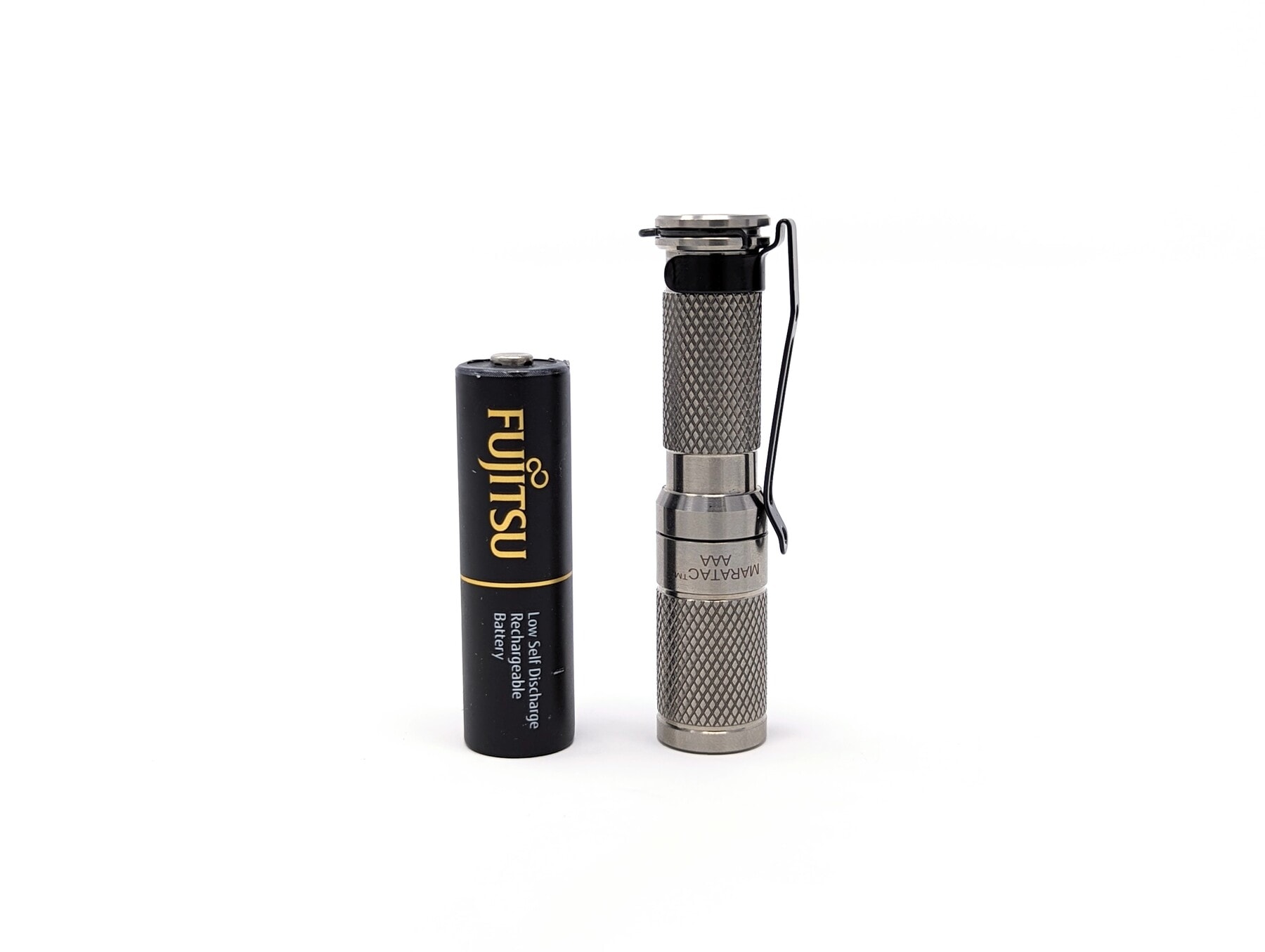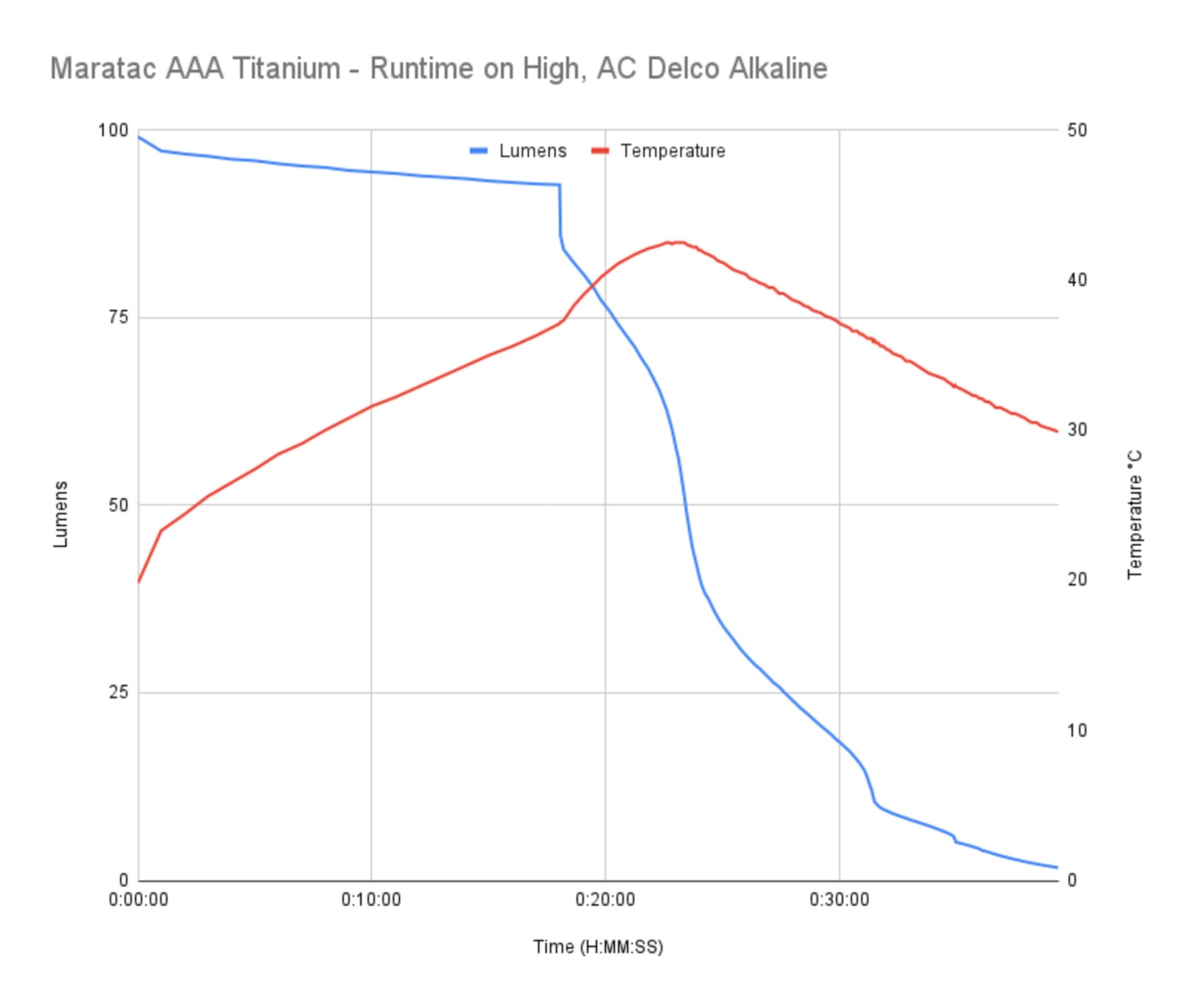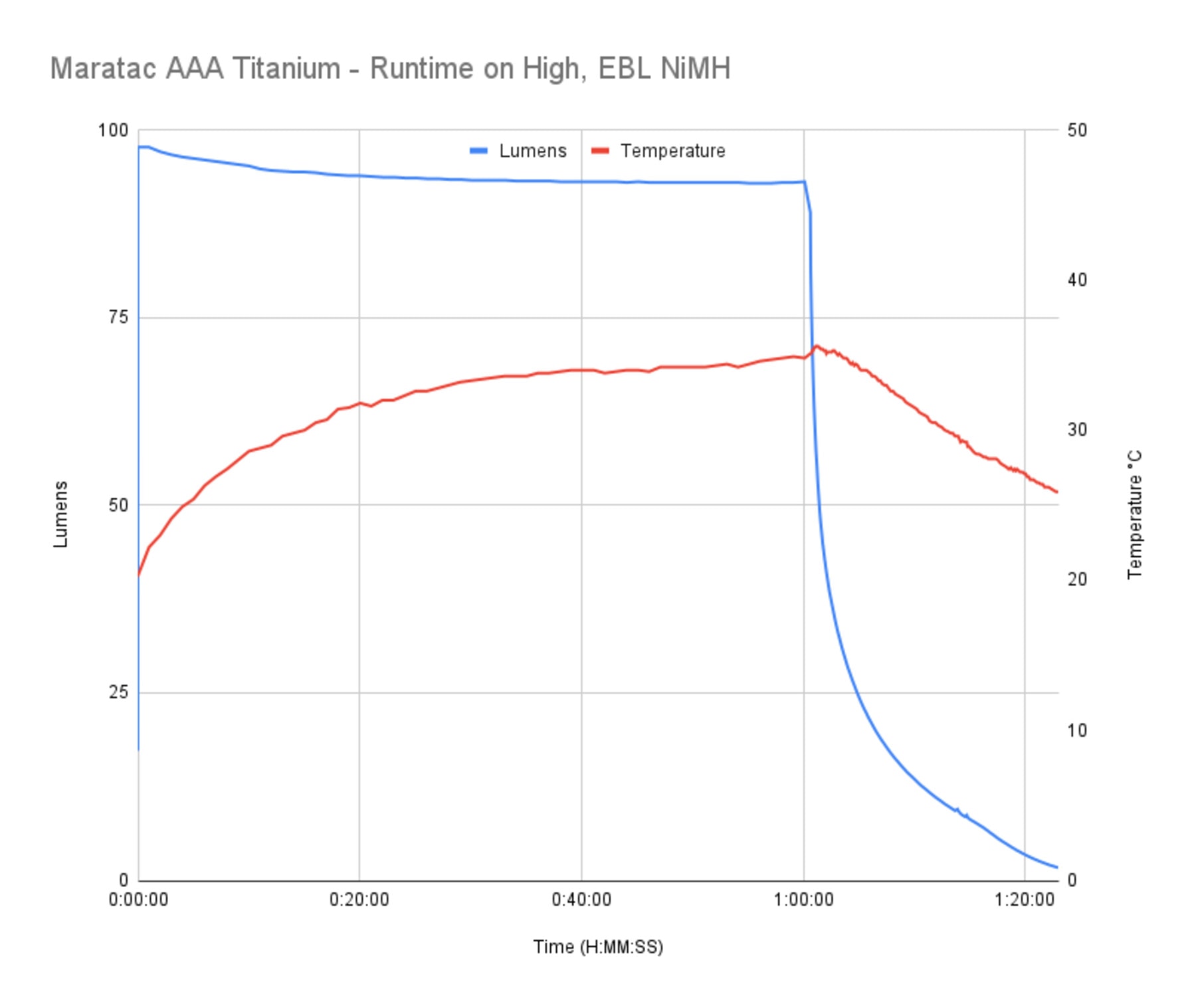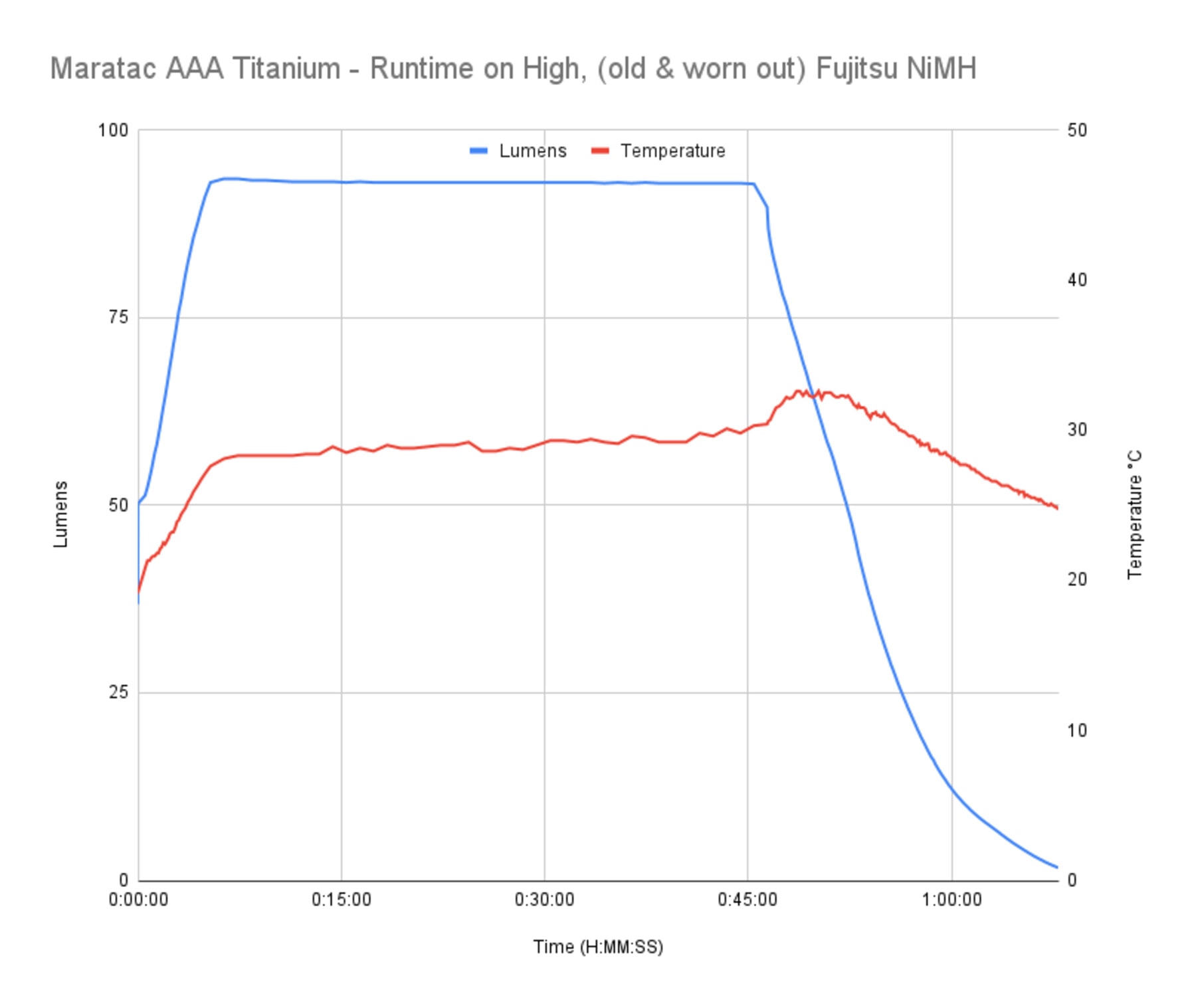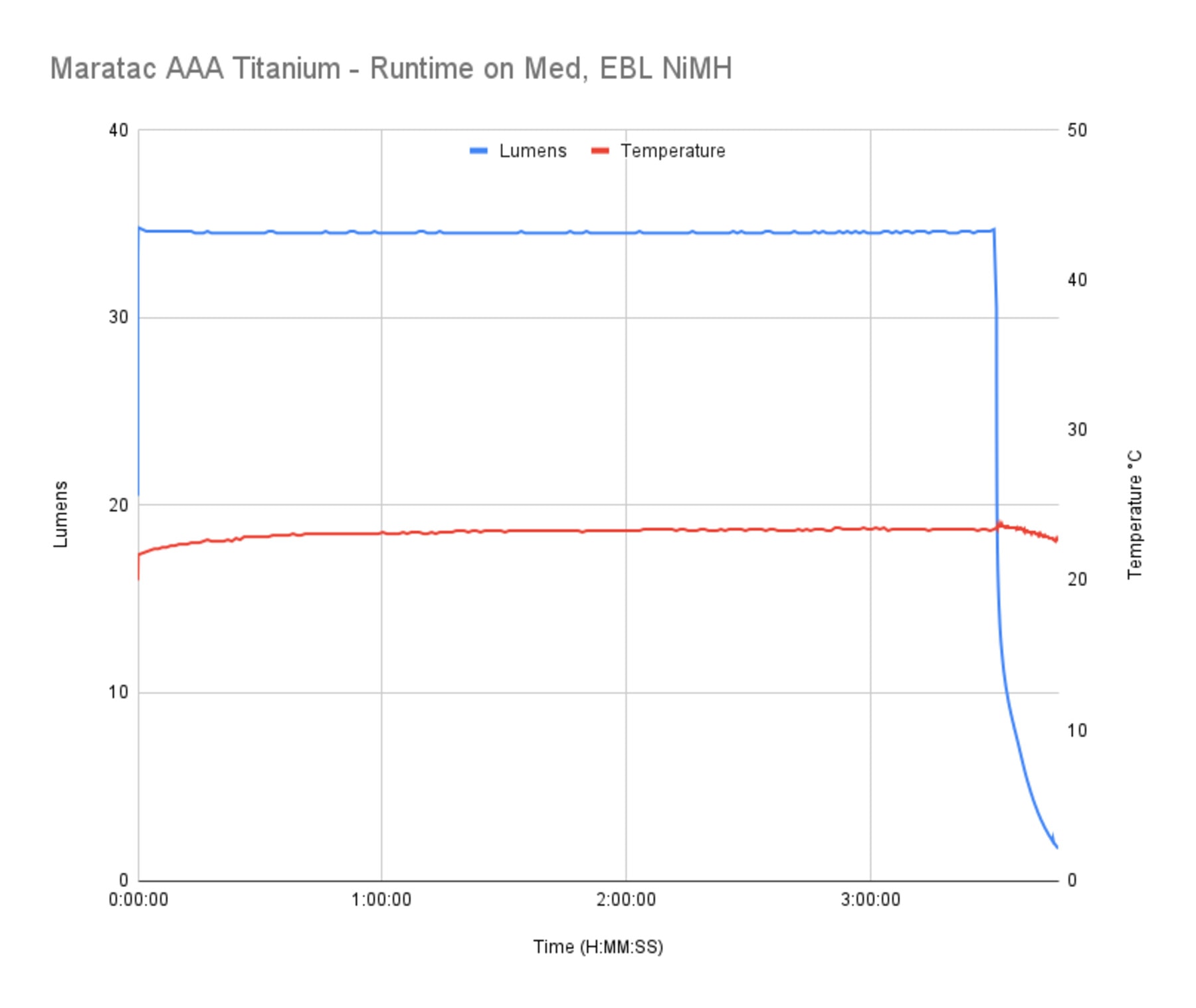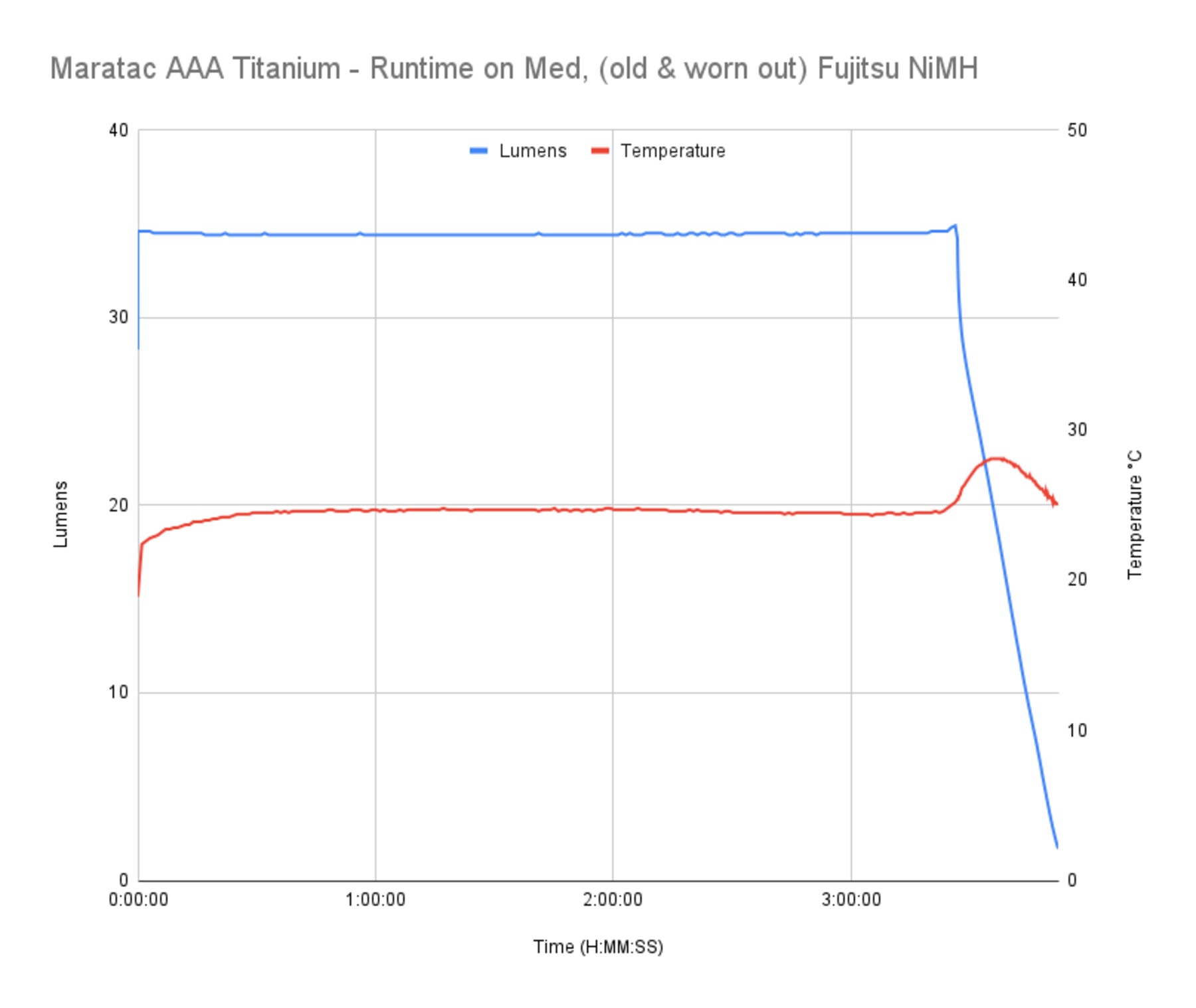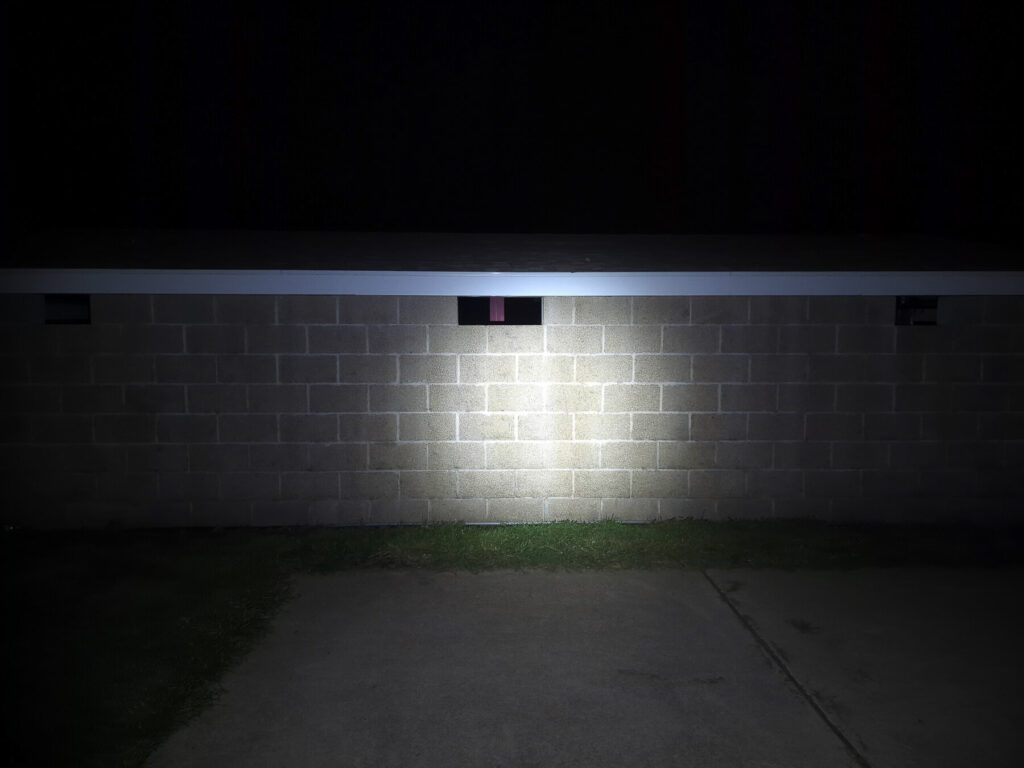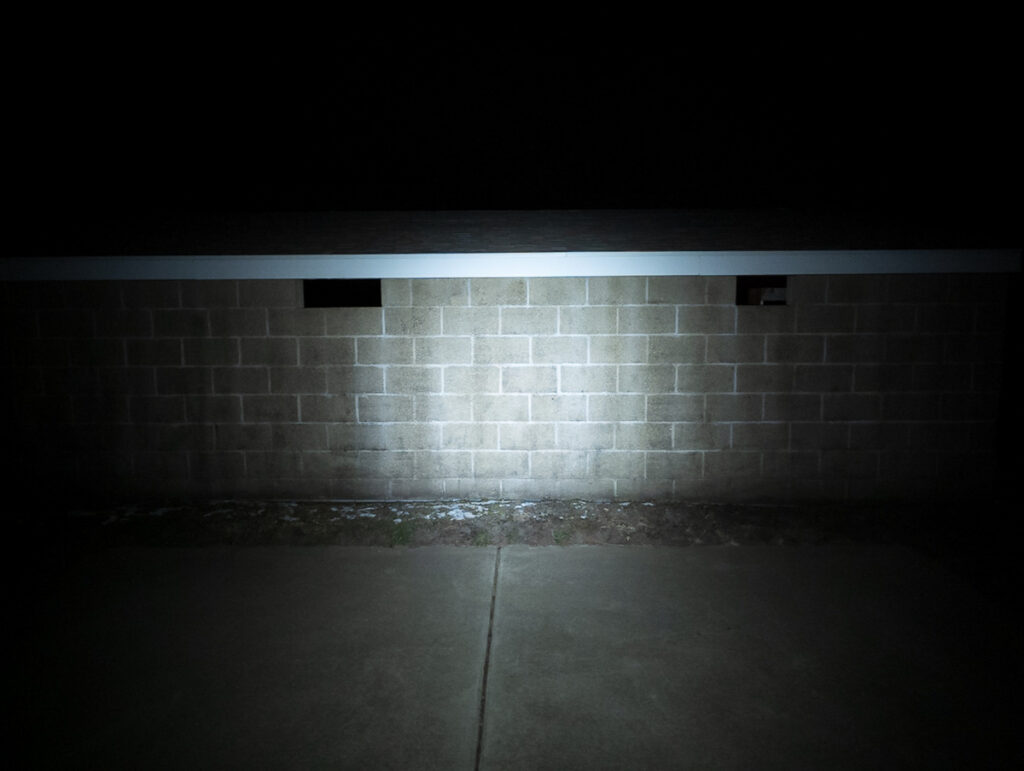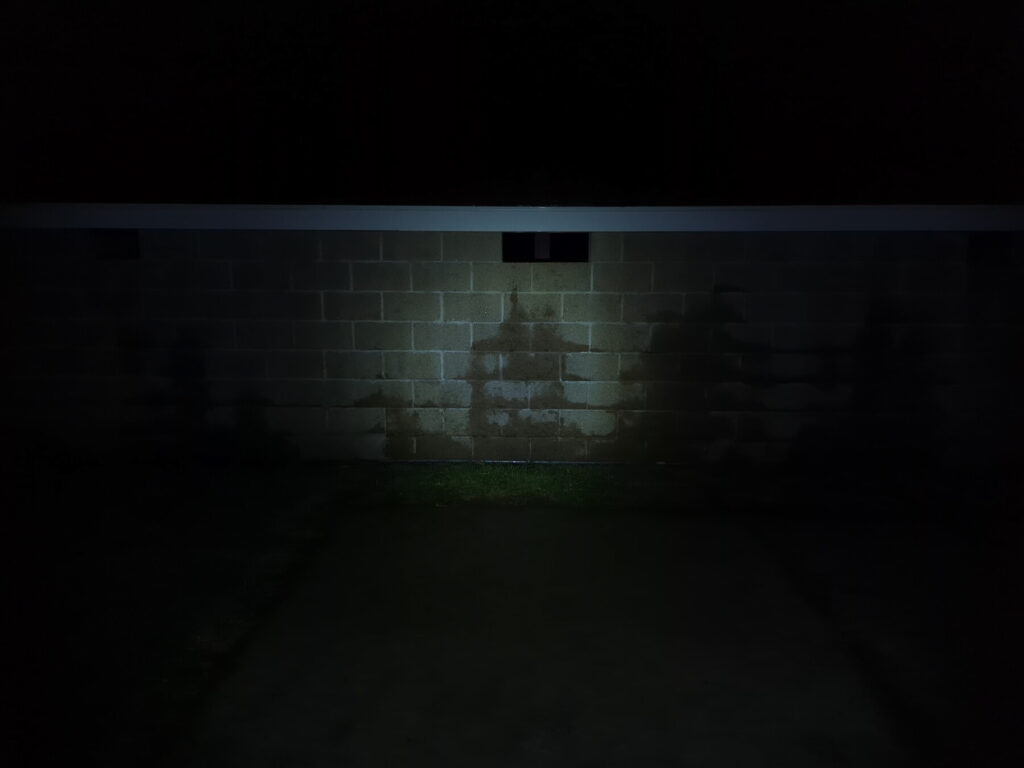1lumen selects and reviews products personally. We may earn affiliate commissions through our links, which help support our testing.
Maratac AAA Titanium Rev 5 review
Maratac AAA Titanium Rev 5 specs
| Brand & Model | Maratac AAA Titanium Rev 5 |
|---|---|
| Flashlight category | Keychain, EDC flashlight |
| LED | Cree XP-G2 S4 (not really) |
| Max. output | 180 lumens |
| Max. beam distance | N/A |
| Max. beam intensity | NA |
| Battery config. | 1x AAA |
| Onboard charging | No |
| Main modes | 3 |
| Blinkies | N/A |
| Waterproof | ?? |
| Review publication date | December 2023 |
Review intro:
The Maratac brand of flashlights are produced by/for a company called CountyComm. It’s a pretty neat company with a lot of awesome, high-quality products. In their own words: CountyComm designs, manufactures and sells select products to federal, state and local government agencies. Specializing in EDC ( Every Day Carry ) or in other places, Limited GOV overrun tactical goods brought to the consumer market. So… they make products to meet the exacting demands of US government agencies and then sell extras (or additional batches) directly to consumers. I’ve purchased items from CountyComm before (like their excellent glow tape) and have had the chance to review a couple of their recent Maratac flashlights, the Maratac Ti Peanut Beast and Maratac Tri Flood Pro.
If you take a look at the Lights section of CountyComm’s website, you might begin to notice that these aren’t 100% original designs. Rather, it seems like CountyComm partners with other known brands (Lumintop, Reylight, Acebeam). The Maratac light may share a similar layout as an existing light, but will have unique aspects like a different UI, materials, or knurling.
CountyComm was kind enough to send their Maratac AAA Titanium Rev 5 flashlight for testing. I noticed this guy pop up in a promotional email from CountyComm, so at the time I thought this Rev 5 was a new version. As it turns out, I think the Rev 5 has actually been around for a few years – this must be just a new overrun batch. That’s ok though, I’m always up for checking out a flashlight – especially when it involves titanium!
To get started with it, you’ll need to pop in a battery (not included).
Package quality.
When I received my first couple of Maratac flashlights, I was a bit shocked at their packaging. Everything was tightly crammed into a little, clear, plastic square-tube. The Maratac AAA Titanium arrived in a slightly different case: a tiny clear one-piece plastic box where the hinged lid was held closed by a small magnet. So while this is a little different, it was still familiar: a very minimalistic clear plastic case. In the case was:
- Maratac AAA Titanium Rev 5
- Glow-in-the-dark diffuser
- Spare o-rings
Yup, very minimalistic – not even a hint of a manual. The back of the case does have 2 sentences about the flashlight and mentions how to insert a battery. But that’s all of the information that you get with the flashlight. I’ve gleaned what I could from CountyComm’s website, but even there the details are a bit scant
Flashlight in use, Build Quality, and Warranty
The Maratac AAA Titanium Rev 5 is a very tiny little twisty light. The Olight i3E EOS is a little bit shorter, but otherwise, it’s pretty much my smallest AAA flashlight. Because of this, it does disappear easily into pants pockets, and I’m sure it would be unobtrusive when hooked to a backpack or purse or something like that.
To help keep it in place, this Maratac comes with a black, steel pocket clip pre-installed. It allows the flashlight to ride deep in the pocket, and for that it works well. But it does seem to be very lightweight, and it doesn’t take much force to pull the clip away from the flashlight. So it’s good for keeping it in position within your pocket, but I wouldn’t rely on it outside your pocket. The clip is reversible so that you could clip it to the brim of a hat if you’d like. There’s another means of carry, the pre-installed lanyard loop. This is something a bit unique; the loop isn’t machined into the body of the flashlight. Rather, it’s a wire loop that is firmly clipped to the body of the flashlight just above the pocket clip.
To me, one of the biggest selling points of this model of Maratac was the body material: titanium. CountyComm mentions that this is “machined from solid 6AL4V Titanium Grade 5.” I have a few titanium flashlights and I love them. Titanium is super strong and fairly lightweight – much less dense than say stainless steel. But it’s not very practical for flashlights, as it is a terrible conductor of heat when compared to materials like copper and aluminum. Thankfully the Maratac AAA Ti doesn’t put out that much heat, so it’s not too much of a concern with this flashlight.
The one downside about titanium that I didn’t think about ahead of time: the threads really aren’t that smooth. That’s not a problem that is specific to this flashlight. I’ve found that to be pretty common among titanium flashlights. I hoped that by removing the factory grease and replacing with a little bit of clean silicone grease would help. And to some extent, it did. But I think part of the blame lies with the spring compression with the battery putting extra force against the threads. Even with the new grease, it’s a bit difficult to twist one-handed. If I remove the battery, it’s much easier to do. So unlike some AAA twisties that I own, this one is much better suited for two-handed use. Part of that is due to its size, though. The Maratac AAA is so short that it’s a bit difficult to wrangle with a single hand.
Overall, I would say that the Maratac AAA Titanium feels well built: the machining is nicely executed. It’s nearly the same exact dimensions as my aluminum Lumintop EDC01 (newer version of the Worm), and the components lego just fine: I can swap the Maratac head onto the Lumintop and it operates, and vice versa. That tells me that the threads are cut identically to the aluminum counterparts. I’m no machinist, but I can’t help but think that there might be a thread style or spacing that would be better suited to the titanium construction.
Warranty coverage: “Full 365 day warranty on all items we sell from defect or failure. We stand behind every product we sell 100% from watches to flashlights, we have you covered!”
LED, Lens, Bezel, Beam, and Reflector
The webpage for the Maratac AAA Titanium Rev 5 specifically calls out that the LED in use here is a Cree XP-G2 S4. I was ready to call bull on that one. A quick glance at the LED had me saying that wasn’t true: the LED substrate is white, whereas the XP-G2 had a silver substrate. The Cree XP-G2 also had visible bond wires, and this LED does not. It looks nothing like what I expected from a Cree XP-G2. But I stand corrected: despite having released the XP-G3 and XP-G4 in recent times, Cree went back and redesigned the old XP-G2 and kept the name the same. You can read a Product Change Notice about that here.
The LED is well centered in a light orange peel reflector. Unfortunately, the OP reflector doesn’t do much to even out the beam. There is a decent amount of tint shift going on. The center of the beam is bluish, surrounded by a ring of yellow-tinted light. The tint shift is very evident when white-wall hunting, but not overly annoying when you’re actually needing light for some task.
CountyComm includes a little diffuser that is kinda handy. It essentially turns your AAA Titanium into a mini lantern. Oh, and it’s GITD (glow in the dark), which is neat.
Spectral measurements:
I used an Opple Light Master to measure the flashlight at 3 meters distance.
| Mode: | CCT: | CRI Ra: | duv |
|---|---|---|---|
| High | 6435 K | 71.0 | +0.0039 |
Site note: I had initially planned to back the pill out of the head and swap the LED, as I have done with similar lights. CountyComm does have a warning about this on their website: “Any attempt to modify these lights will void the warranty. We know when you try to remove the pill.” Well, I’m not always someone that listens to directions. I tried backing out the pill and it didn’t want to budge. If it’s similar to other lights, the pill is reverse threaded. But even trying that, I couldn’t get it to loosen up. I’m pretty sure the pill is glued in there. So I guess it’s going to stay with this “meh” LED, at least until I get a wild hair again.
Dimensions and its competition
Dimensions:
| Maratac AAA Ti | Millimeters | Inches |
|---|---|---|
| Length | 67 mm | 2.6 in |
| Head diameter | 14 mm | 0.6 in |
| Body diameter | 12 mm | 0.5 in |
Dimensions are rounded to the nearest millimeter, and to the nearest tenth of an Inch.
Weight:
| Maratac AAA Ti | Weight in grams | Weight in oz |
|---|---|---|
| Without battery: | 16 g | 0.6 oz |
| With battery (Fujistu / Eneloop 900 mAh) | 29 g | 1.0 oz |
Weight is rounded to the nearest gram, and to the nearest tenth of an Oz.
Flashlight size comparison with its competition:
Group 1: Jetbeam Jet-u, ThruNite Ti3 V2, Maratac AAA Titanium, Olight i3E EOS, Skilhunt E3A
Group 2: Olight Baton 4, Maratac AAA Titanium, Rovyvon A3 Pro MAO
Group 3: Fujitsu AA battery, Maratac AAA Titanium
Maratac AAA Titanium Rev 5 UI: User Interface and Driver
The UI is about as easy as you can get. It’s a twisty, so tighten the head down to turn it on. Loosen the head to turn it off. Give it a quick twist off and back on in order to rotate through the modes.
Available modes:
- Low, Medium, High
Available blinky modes:
- N/A
From OFF:
- Twist on
From ON:
- Quick twist off & back on: change modes
- Twist off
Mode memory:
- It appears that there is mode memory, though it isn’t called out on CountyComm’s website (it doesn’t mention anything about memory)
Shortcuts:
- N/A
Low voltage warning/protection:
- N/A
Strobe/blinkies
- N/A
Lock-out mode:
- N/A
PWM
- No: none visible, nor detected with a photodiode + DMM on Hz setting
Additional/summary info on the UI:
- I’m really not a big fan of the Medium > Low > High mode order
Maratac AAA Titanium Rev 5 Charging and batteries
The Maratac AAA Titanium uses AAA-sized batteries. Lithium-ion rechargeables are not recommended. So feed your light with quality NiMH batteries. Or if you’re spendy, go with lithium primaries. You can use a quality alkaline, but I’m not much of a fan because of experiences with them leaking and ruining flashlights and other gadgets – they’ll work in a pinch though.
The quality of your battery will have an affect on the output of the flashlight. I first tried a Fujitsu (Eneloop) AAA 900 mAh cell that I’ve had around for several years. It didn’t fare so well: output started at only 50 lumens, but by 5 minutes the brightness had gradually increased to 93 lumens. I put the Fujistu cell on my Vapcell S4+ charger and sure enough, the internal resistance was very high (around 600 Ohms if memory serves me right).
I tried a cheaper NiMH battery I had sitting around, an EBL. While it’s not what I would consider to be a high-quality cell, it is newer and has a lower internal resistance. It didn’t need any warm-up period. The EBL started at 98 lumens, and then gradually tapered off as you’d expect.
I also tried a fresh alkaline that I had on hand, an AC Delco. That battery started off at 99 lumens, neck and neck with the EBL NiMH battery.
| Charge type | Fits | No fit | Charge time |
|---|---|---|---|
| None | AAA batteries: NiMH, alkaline, and lithium primaries | 10440 batteries (fits, but not recommended for use) | N/A |
Performance test
Lumen measurements
How Lumens are Measured: Understanding ANSI FL1 Standards How Lumens are Measured: Understanding ANSI FL1 Standards: The ANSI FL1 standards specify that output in lumens should be measured 30 seconds after turning on, as this is the standardized time for measuring brightness according to the industry standard. This is why we focus on this part in our measurements. The ANSI FL1 standards require an ambient temperature of 22 ± 3°C. We record the ambient the ambient temperature to identify potential reasons for any observed discrepancies.Lux was measured by a UNI-T UT383 BT at 1 meter. Lumens were measured in a homemade lumen tube using a VEML7700 sensor, calibrated with a calibration light provided by 1Lumen. A few different batteries were used for testing: a Fujitsu (Eneloop) NiMH, an EBL NiMH, and an AC Delco alkaline.
| Mode | Specified | 0 sec. | 30 sec. | 10 min. |
|---|---|---|---|---|
| AC Delco Alkaline, High | 180 lm | 99 lm | 98 lm | 94 lm |
| EBL NiMH, Med | 65 lm | 35 lm | 35 lm | 35 lm |
| EBL NiMH, High | 180 lm | 98 lm | 98 lm | 95 lm |
| Fujitsu NiMH, Low | 5 lm | 4 lm | 4 lm | 4 lm |
| Fujitsu NiMH, Med | 65 lm | 35 lm | 35 lm | 35 lm |
| Fujitsu NiMH, High | 180 lm | 50 lm | 52 lm | 93 lm |
Parasitic drain:
- N/A – it’s a twisty
So… there’s a few things going on here. First off, my Fujitsu NiMH battery is clearly showing signs of age and goes to show that a good battery can improve a flashlight’s performance. Secondly, alkaline batteries work in a pinch, but they just can’t sustain the output like a NiMH battery can. Lastly, no matter what I tried, I couldn’t get anywhere near Maratac’s claim of 180 lumens. The relatively fresh NiMH and the alkaline battery both got up to 98-99 lumens and the worn out NiMH saw 93 lumens. So I’d be comfortable calling this a 100 lumen flashlight. But the claim of 180 lumens is just a bit too optimistic.
Medium mode was also well short of the spec. I don’t mind a 35 lumen medium mode for a AAA light, but still – just like the High mode, I measured 55% of the lumen claim.
Low was pretty close to spec, and is a nicely usable 4 lumens. Some people like to see a moonlight or firefly mode, but I think this 4 lumen mode is perfectly suitable for a lot of low-light tasks.
Maratac AAA Titanium Rev 5 Battery Life: Runtime graphs
How Runtimes are Measured: Understanding ANSI FL1 Standards About ANSI FL1 runtime standards: The runtime is measured until the light drops to 10% of its initial output (30 seconds after turning on). This does not mean that the flashlight is not usable anymore. The last column shows how long the light actually works till it shuts off. If there is a + symbol, it means that the test was stopped at that particular point, but the light was actually still running. This happens on certain occasions, with certain drivers, firmware, or batteries.| Mode | Specified | Measured runtime ANSI | Time till shut off |
|---|---|---|---|
| Low | 65h | ||
| AC Delco Alkaline, High | 1h 15min | 32min | 39min+ |
| EBL NiMH, Med | 10h | 3h 41min | 3h 46min+ |
| EBL NiMH, High | 1h 15min | 1h 13min | 1h 23min+ |
| Fujitsu NiMH, Med | 10h | 3h 50min | 3h 52min+ |
| Fujitsu NiMH, High | 1h 15min | 1h 4min | 1h 7min+ |
Just like the lumen output claims, these don’t seem to make a whole lot of sense. All of Maratac’s claims say they were tested with a Duracell AAA battery. Is a Duracell better than the AC Delco that I used for my testing? Perhaps. Is it going to get 80% more output and 135% more runtime? I highly doubt it. Granted, the EBL NiMH pretty much met the runtime claim, albeit at a much lower brightness than spec. And just like a lot of the claims, the Med mode runtime seems just as optimistic.
Peak beam intensity and beam distance measurements
About Peak beam intensity: Understanding ANSI FL1 Standards About peak beam intensity The calculated value of distance in meters at which the flashlight produces a light intensity of 0.25 lux. (0.25 lux is about the brightness of a full moon shining on an object). This means that the intensity has decreased so much, it becomes difficult to see darker objects, or objects that don’t reflect light. The columns ‘Meters’ and ‘Yards’ use rounded numbers.Due to the low level of output, throw was tested at 1 meter with my UNI-T UT383 BT. I used the EBL NiMH for these tests.
| Mode | Specified | Candela measured | Meters | Yards |
|---|---|---|---|---|
| Low | – | 23 cd | 10 m | 10 yd |
| Medium | – | 201 cd | 28 m | 31 yd |
| High | – | 599 cd | 49 m | 54 yd |
Well, at least these figures aren’t lower than the specifications. But that’s only because I can’t find an intensity spec anywhere to compare my test results against.
Beamshots
Beam shots of the building are taken at 5 m (5.5 yd) using a Pixel 7 set to ISO 800 with 1/30 second exposure time
Beamshots of the following flashlights compared:
- Maratac AAA Ti
- Rovyvon A3 Pro G4 MAO
- NEXTORCH K40
Please note that beamshots are mainly intended to showcase the beam pattern and beam quality, rather than overall performance. These images are typically taken directly after activation, and do not fully represent its overall performance. For accurate performance metrics, such as output, beam distance, and runtimes, you need to look at the performance section of this review.
Disclaimer: This flashlight was sent to us for review at no cost by Countycomm. We have not been paid to review, nor have we been holding back on problems or defects.
Final Verdict
Pros
- Titanium
- Beautiful build
- Deep carry
Cons
- Way under spec
- Difficult to twist
- Med > Low > High mode order
- Cold white
- Tint shift
- No ability to mode
Explanation on star ratings:
1: Avoid: a match would be a better choice – 2: Poor: significant defect or issues; almost unusable – 3: Average: some defects or issues; but still usable 4: Good: recommended (minor issues) – 5: Great: highly recommended
3 stars: ★★★
While our star rating provides a reliable indicator, we encourage you to read the full review to make an informed decision based on your own needs and preferences.
I came into this review with excitement and high hopes. Part of that is because I just love a good titanium flashlight: they’re strong, light, and beautiful (generally speaking). The Maratac AAA Titanium Rev 5 has those qualities, and that’s about where the good news ends. It terribly misses the output specs. The twisting action is really tough and gritty, which is partially just the nature of machined titanium (though I suspect it could be better).
And that new Cree XP-G2 that they used is cold, low CRI, and has bad tint shift. No problem for a modder – just replace it, right? Nope, these things seem to be glued up tight and Maratac specifically says to not even try it or they’ll void your warranty.
At this point, the Maratac AAA Titanium Rev 5 is essentially a neat pocket fidget toy that I could use as a flashlight if I absolutely needed one in a pinch. If you really love titanium or want to complete a set of Maratac AAA flashlights (they have a lovely copper option!), then go for it. But if you’re in need of a well functioning AAA flashlight, you’re best off looking elsewhere.
Buy your Maratac AAA Titanium Rev 5 here
1lumen selects and reviews products personally. We may earn affiliate commissions through our links, which help support our testing.
